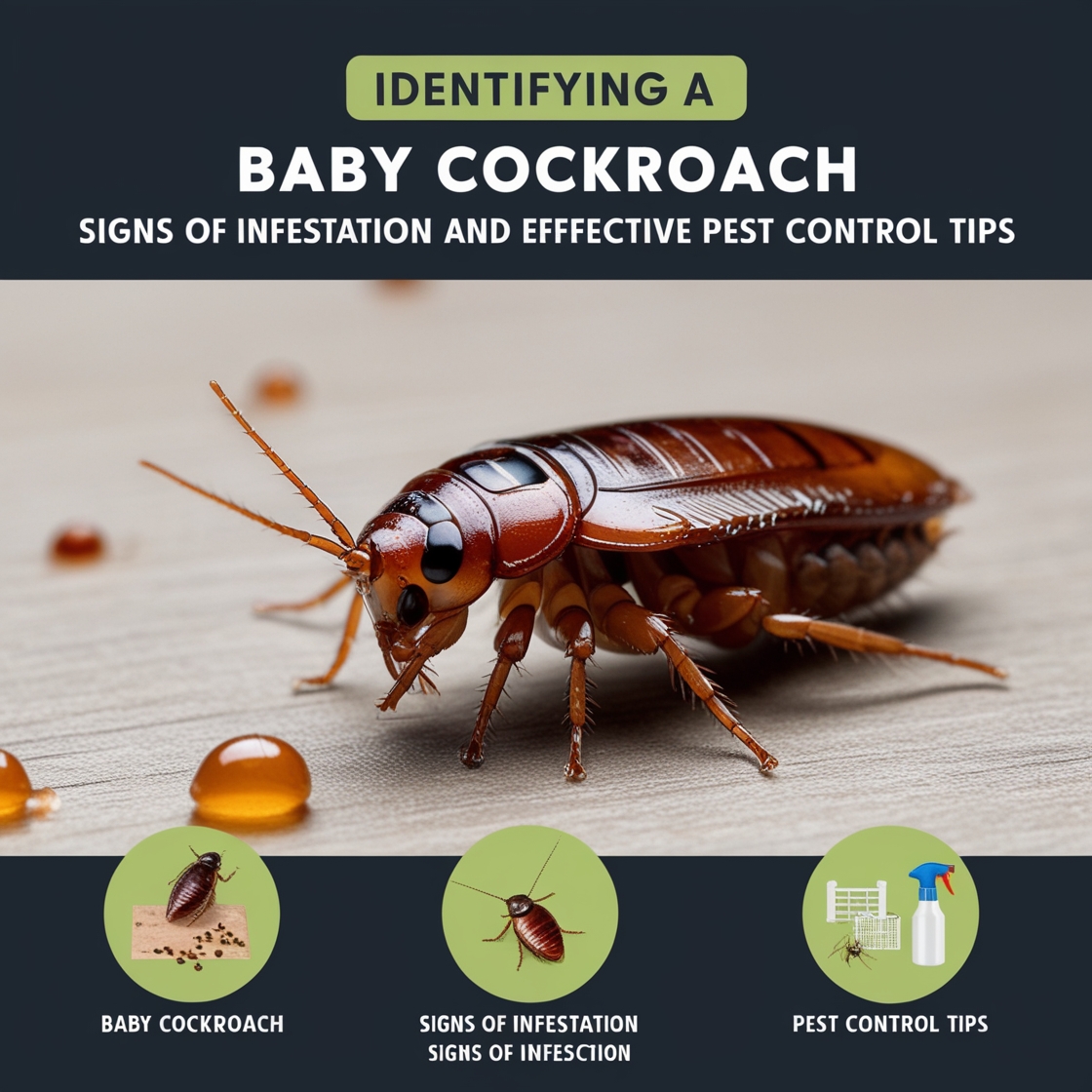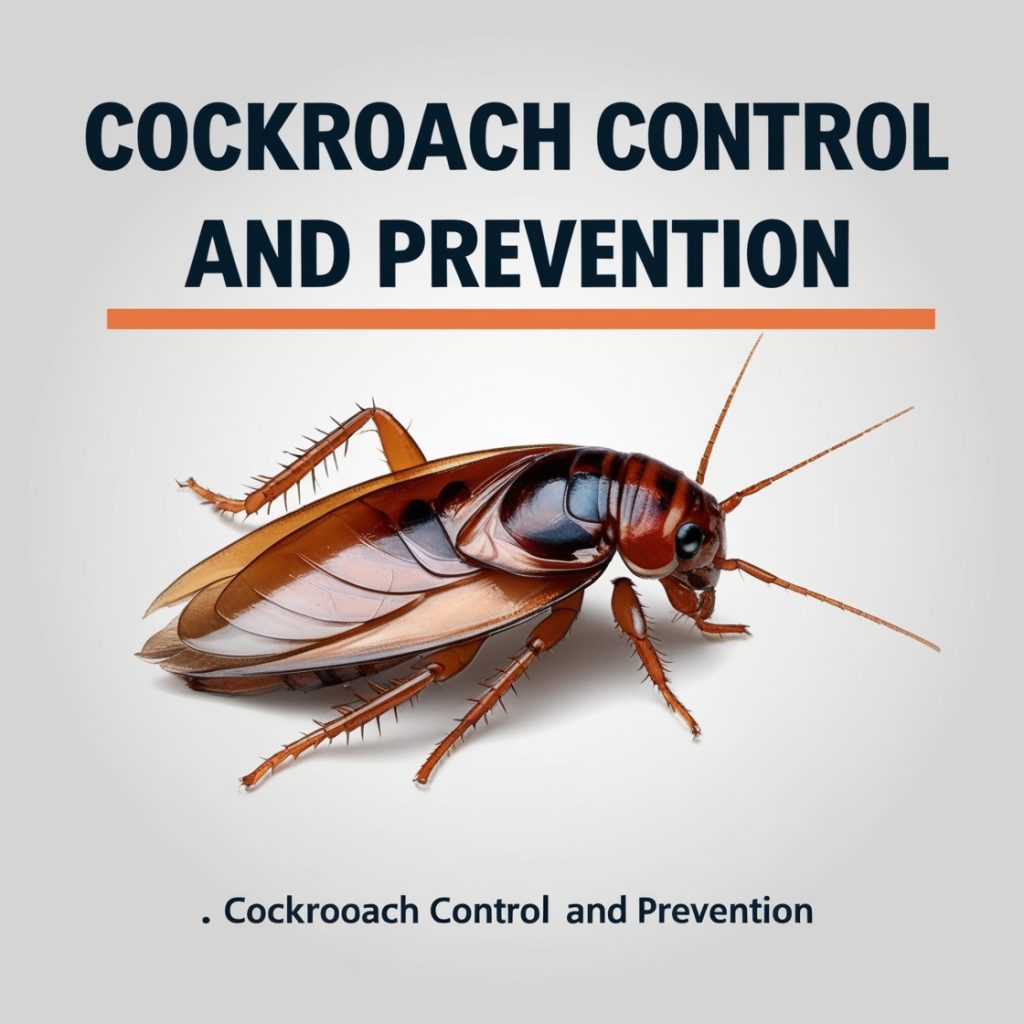Identifying Baby Cockroach: Signs of Infestation and Pest Control

- Identifying Baby Cockroaches
- Signs of a Cockroach Infestation
- Cockroach Control and Prevention
- Understanding the Cockroach Life Cycle
- Preventing Future Infestations
- Maintaining a Roach-Free Environment
- When to Call Professional Pest Control
- Conclusion: Staying Vigilant Against Cockroach Infestations
Discover how to identify baby cockroaches and signs of infestation. Learn effective pest control tips to eliminate nymphs and protect your home from roaches.
What Are Cockroach Nymphs?
Cockroaches are notorious pests that have plagued humans for centuries. These resilient insects are known for their rapid reproduction and adaptability, making them a persistent problem for homeowners and businesses alike. To effectively combat a cockroach infestation, it’s crucial to understand all stages of their life cycle, including the often-overlooked baby cockroaches, also known as nymphs.
Baby cockroaches, or cockroach nymphs, are the immature form of cockroaches. These young roaches hatch from egg cases and go through several molting stages before reaching adulthood. Nymphs are essentially miniature versions of adult cockroaches, lacking fully developed wings and reproductive capabilities. Understanding the characteristics and behavior of baby cockroaches is essential for identifying and addressing infestations early on.
Why Identifying Baby Roaches Is Crucial
Identifying baby cockroaches is a critical skill for any homeowner or pest control professional. The presence of baby cockroaches usually indicates a larger infestation problem, as cockroaches are prolific breeders. Seeing baby roaches means that adult cockroaches have found suitable conditions to reproduce and thrive in your environment.
Early detection of baby cockroaches can help prevent a full-blown infestation, saving you time, money, and stress in the long run. By recognizing the signs of baby roaches, you can take prompt action to eliminate the pests before they multiply and spread throughout your home or business.
Identifying Baby Cockroaches
What Do Baby Cockroaches Look Like?
Baby cockroaches look like smaller versions of adult cockroaches, but there are some key differences to note. Here are some general characteristics of baby cockroaches:
1. Size: The size of a baby cockroach will vary depending on the species and its stage of development. Newly hatched nymphs can be as small as 1/8 inch long, while older nymphs may reach up to 1/2 inch in length.
2. Color: Baby cockroaches are usually lighter in color than adults. They often appear white or pale brown immediately after hatching and darken as they age.
3. Wings: Unlike adult cockroaches, nymphs lack fully developed wings. You may notice small wing buds on older nymphs, but these are not functional for flight.
4. Antennae: Baby cockroaches have long antennae, similar to adults, which they use to sense their environment.
5. Body shape: Nymphs have a flatter, more oval-shaped body compared to adults.
6. Legs: Like adult cockroaches, baby cockroaches have six legs that allow them to move quickly.
Differences Between Baby Roaches and Bed Bugs

It’s important to differentiate between baby cockroaches and other small pests, such as bed bugs. While both can be found in homes, they have distinct characteristics:
1. Size: Baby cockroaches are generally larger than bed bugs, even in their earliest stages.
2. Shape: Cockroach nymphs have a more elongated, oval shape, while bed bugs are rounder and flatter.
3. Color: Bed bugs are typically reddish-brown, while baby cockroaches range from white to light brown.
4. Legs: Baby cockroaches have longer legs compared to the shorter legs of bed bugs.
5. Antennae: Cockroach nymphs have long, prominent antennae, whereas bed bugs have shorter, less noticeable antennae.
6. Movement: Baby cockroaches are fast movers, while bed bugs tend to be slower and more deliberate in their movements.
Common Species of Baby Cockroaches
Baby German Cockroaches
German cockroaches are one of the most common household pests. Baby German cockroaches are typically light brown or tan with two dark parallel stripes running down their backs. These nymphs are small, usually measuring about 1/4 inch in length. German cockroach nymphs develop quickly, reaching adulthood in as little as 36 days under ideal conditions.
Baby American Cockroaches
American cockroaches are larger than their German counterparts. Baby American cockroaches start as a grayish-brown color and gradually darken as they mature. They can grow up to 1 inch long during their nymph stages. American cockroach nymphs take longer to develop, with a nymph stage lasting several months.
Baby Brown-Banded Cockroaches
Brown-banded cockroach nymphs are distinguished by the two light bands that run across their dark brown bodies. These bands are more pronounced in nymphs than in adults. Baby brown-banded cockroaches are smaller than American cockroach nymphs, typically measuring about 1/4 inch in length.
Baby Oriental Cockroaches
Oriental cockroach nymphs are dark brown or black and have a glossy appearance. They are slower-moving compared to other cockroach species and prefer cooler, damper environments. Baby oriental cockroaches can grow up to 3/4 inch long during their nymph stages.
Signs of a Cockroach Infestation
Finding Baby Cockroaches in Your Home
Discovering baby cockroaches in your home is often the first sign of a cockroach infestation. These small pests can be found in various areas of your house, particularly in warm, humid environments with access to food and water. Common places to find baby cockroaches include:
1. Kitchen: Look for nymphs in cabinets, under appliances, and near food storage areas.
2. Bathrooms: Check under sinks, behind toilets, and in dark corners.
3. Basements: Inspect damp areas, storage boxes, and cluttered spaces.
4. Laundry rooms: Examine areas around washing machines and dryers.
5. Garages: Look in cardboard boxes, near pet food, and in dark corners.
Where to Look for Baby Roaches
To effectively identify a cockroach infestation, it’s essential to know where to look for baby roaches. These pests are nocturnal and prefer dark, hidden spaces. Here are some specific areas to inspect:
1. Cracks and crevices: Baby cockroaches can squeeze into tiny spaces, so check for them in wall cracks, floor gaps, and around baseboards.
2. Behind furniture: Move couches, dressers, and other large furniture to inspect hidden areas.
3. Under sinks: Look for nymphs in the moist environments beneath kitchen and bathroom sinks.
4. Inside appliances: Check behind and under refrigerators, stoves, and dishwashers.
5. In drains: Cockroach nymphs may hide in sink and floor drains.
6. Cardboard boxes: Inspect storage boxes, especially in basements and garages.
7. Bookshelves: Look between and behind books for small cockroaches.
What Seeing Baby Cockroaches Means for Your Home
The presence of baby cockroaches in your home is a serious concern. Here’s what it typically indicates:
1. Active infestation: Seeing baby cockroaches means that adult cockroaches are successfully breeding in your home.
2. Favorable conditions: Your home provides suitable conditions for cockroaches to thrive, including food, water, and shelter.
3. Potential health risks: Cockroaches can carry bacteria and allergens, posing health risks to you and your family.
4. Need for immediate action: A cockroach infestation requires prompt attention to prevent it from worsening.
5. Possible structural issues: Cockroaches may be entering through cracks or gaps in your home’s structure.
Cockroach Control and Prevention

How to Get Rid of Baby Cockroaches
Dealing with baby cockroaches requires a multi-faceted approach. Here are some effective methods to eliminate these pests:
1. Sanitation: Thoroughly clean your home, paying special attention to kitchens and bathrooms. Remove food debris, fix leaks, and reduce clutter.
2. Seal entry points: Inspect your home for cracks, gaps, and holes that cockroaches may use to enter. Seal these openings with caulk or other appropriate materials.
3. Use cockroach baits: Place baits in areas where you’ve seen cockroach activity. Baits are effective because nymphs will consume them and spread the poison to other roaches.
4. Apply insecticide dust: Use a residual insecticide dust in cracks, crevices, and void spaces where cockroaches hide.
5. Employ growth regulators: Insect growth regulators (IGRs) can prevent nymphs from developing into reproductive adults.
6. Set sticky traps: Use sticky traps to monitor cockroach activity and catch nymphs.
7. Natural remedies: Some homeowners find success with natural deterrents like diatomaceous earth or boric acid, but these should be used cautiously, especially in homes with pets or children.
Effective Pest Control Services for Roach Infestations
While DIY methods can be helpful, severe infestations often require professional pest control services. Here’s what to expect from a professional cockroach control service:
1. Inspection: A thorough assessment of your property to identify the extent of the infestation and potential entry points.
2. Customized treatment plan: Based on the inspection, the pest control expert will develop a targeted strategy to eliminate the cockroach population.
3. Application of professional-grade products: Pest control professionals have access to more potent and effective treatments than those available to consumers.
4. Integrated Pest Management (IPM): A comprehensive approach that combines chemical treatments with environmental modifications and preventive measures.
5. Follow-up visits: Most professional services include follow-up treatments to ensure the infestation is fully eradicated.
6. Education: Pest control experts can provide valuable advice on preventing future infestations.
DIY Methods to Eliminate Cockroach Nymphs
For those who prefer to tackle the problem themselves, here are some DIY methods to get rid of cockroach nymphs:
1. Boric acid: Sprinkle boric acid in areas where you’ve seen cockroach activity. It’s toxic to roaches but relatively safe for humans and pets when used correctly.
2. Diatomaceous earth: This natural substance can dehydrate and kill cockroaches. Apply it in thin layers where roaches travel.
3. Essential oils: Some essential oils, like peppermint and tea tree oil, may repel cockroaches. Mix with water and spray in affected areas.
4. Homemade baits: Create baits using a mixture of boric acid, sugar, and flour to attract and kill roaches.
5. Vacuuming: Regular vacuuming can help remove cockroach eggs and nymphs from carpets and hidden areas.
6. Cleanliness: Maintain a clean home, especially in the kitchen and bathroom, to reduce food and water sources for cockroaches.
Remember, while these DIY methods can be effective for small infestations, larger or persistent problems may require professional intervention.
Understanding the Cockroach Life Cycle
From Egg to Nymph: How Cockroaches Hatch
Understanding how cockroaches hatch and develop is crucial for effective pest control. Here’s an overview of the cockroach life cycle:
1. Egg stage: Female cockroaches produce egg cases called oothecae. Depending on the species, a single ootheca can contain 10 to 50 eggs.
2. Incubation: The incubation period varies by species. For example, German cockroaches carry the ootheca until just before hatching, while American cockroaches deposit the egg case in a hidden location.
3. Hatching: When cockroaches hatch, they emerge as tiny, white nymphs. These newly hatched cockroaches are extremely vulnerable and will quickly seek shelter and food.
4. Nymph stage: As nymphs, cockroaches go through several molting stages, shedding their exoskeletons as they grow. The number of molts varies by species, ranging from 5 to 8 stages.
5. Development: During the nymph stage, cockroaches gradually develop their characteristic features, including darkening color and the formation of wing buds.
Growth Stages of Baby Roaches
The growth of baby roaches occurs in distinct stages:
1. First instar: Newly hatched nymphs are white or light-colored and measure about 1/8 inch long.
2. Middle instars: As nymphs molt and grow, they become darker and larger. Their bodies begin to resemble adult cockroaches, but they lack fully developed wings.
3. Final instar: In the last nymph stage, wing buds become more prominent, and the cockroach reaches nearly adult size.
4. Adult stage: After the final molt, cockroaches emerge as fully developed adults with functional wings (in most species) and reproductive capabilities.
The time it takes for a baby cockroach to reach adulthood varies by species:
– German cockroaches: 36-100 days
– American cockroaches: 6-12 months
– Brown-banded cockroaches: 8-31 weeks
– Oriental cockroaches: 6-12 months
Understanding these growth stages is essential for identifying the age of cockroach nymphs and determining the best control methods.
Preventing Future Infestations
Identifying and Sealing Entry Points
One of the most effective ways to prevent cockroach infestations is to eliminate their access to your home. Here’s how to identify and seal potential entry points:
1. Inspect the exterior: Walk around the outside of your home, looking for cracks in the foundation, gaps around pipes, and openings around windows and doors.
2. Check indoor spaces: Examine baseboards, flooring, and walls for small cracks or gaps that cockroaches could use to move between rooms.
3. Seal openings: Use caulk, steel wool, or appropriate sealants to close off any discovered entry points. Pay special attention to areas around pipes and electrical outlets.
4. Install door sweeps: Add door sweeps to exterior doors to prevent cockroaches from entering underneath.
5. Repair damaged screens: Ensure all window and door screens are intact and properly fitted.
6. Address plumbing issues: Fix any leaky pipes or faucets, as moisture attracts cockroaches.
Maintaining a Roach-Free Environment
Creating an environment that’s inhospitable to cockroaches is key to preventing future infestations:
1. Practice good sanitation: Regularly clean your home, paying special attention to kitchens and bathrooms. Wipe down counters, sweep floors, and vacuum carpets frequently.
2. Manage food storage: Store food in airtight containers and avoid leaving pet food out overnight.
3. Reduce clutter: Cockroaches love hiding in cluttered areas. Minimize piles of newspapers, cardboard boxes, and other potential hiding spots.
4. Control moisture: Fix leaks promptly and use dehumidifiers in damp areas like basements.
5. Proper waste management: Use trash cans with tight-fitting lids and dispose of garbage regularly.
6. Inspect incoming items: Check boxes, grocery bags, and secondhand furniture for signs of cockroaches before bringing them into your home.
7. Maintain the exterior: Keep your yard free of debris and store firewood away from the house.
8. Regular inspections: Conduct periodic checks of your home for signs of cockroach activity, especially in prone areas like kitchens and bathrooms.
When to Call Professional Pest Control
Signs It’s Time for Expert Intervention
While many cockroach problems can be handled with DIY methods, some situations call for professional pest control services. Consider contacting a pest control expert if:
1. You see large numbers of cockroaches, especially during the day.
2. DIY treatments have been ineffective after several attempts.
3. You find baby cockroaches frequently, indicating a growing infestation.
4. Cockroaches are appearing in multiple areas of your home.
5. You have a cockroach allergy or asthma that’s being exacerbated by the infestation.
6. The infestation is affecting your quality of life or causing significant stress.
7. You’re dealing with a hard-to-treat species like the German cockroach.
8. The infestation has spread to neighboring units in an apartment or condominium.
What to Expect from Cockroach Control Services
When you hire a professional pest control service for cockroach control, here’s what you can typically expect:
1. Initial inspection: A thorough examination of your property to assess the extent of the infestation and identify problem areas.
2. Customized treatment plan: Based on the inspection, the pest control expert will develop a targeted strategy to eliminate the cockroach population.
3. Use of professional-grade products: Pest control professionals have access to more potent and effective treatments than those available to consumers.
4. Integrated Pest Management (IPM) approach: A comprehensive strategy that combines chemical treatments with environmental modifications and preventive measures.
5. Safe application: Professional pest control services are trained to apply treatments safely, minimizing risks to humans and pets.
6. Follow-up visits: Most services include follow-up treatments to ensure the infestation is fully eradicated.
7. Guidance on prevention: Pest control experts can provide valuable advice on preventing future infestations and maintaining a pest-free home.
8. Guarantee: Many professional services offer a guarantee on their work, providing peace of mind and additional treatments if necessary.
Conclusion: Staying Vigilant Against Cockroach Infestations
Dealing with baby cockroaches and preventing full-blown infestations requires vigilance, knowledge, and proactive measures. By understanding the life cycle of cockroaches, recognizing the signs of their presence, and implementing effective control and prevention strategies, you can maintain a cockroach-free environment in your home or business.
Remember that the presence of baby cockroaches usually indicates a larger problem. These nymphs are not just a nuisance; they represent the next generation of pests that can quickly multiply and spread throughout your living spaces. Early detection and swift action are crucial in managing cockroach populations effectively.
Key takeaways from this article include:
- Identification: Knowing how to identify baby cockroaches of different species is the first step in addressing an infestation. Remember that nymphs look like smaller versions of adult cockroaches, lacking fully developed wings.
- Regular inspections: Conduct routine checks of your property, focusing on areas prone to cockroach activity such as kitchens, bathrooms, and basements.
- Sanitation: Maintaining a clean environment is one of the most effective ways to prevent and control cockroach infestations. Regular cleaning, proper food storage, and waste management are essential.
- Sealing entry points: Cockroaches can squeeze through tiny openings, so identifying and sealing potential entry points is crucial for long-term prevention.
- Integrated approach: Combining various methods, including baits, traps, and environmental modifications, often yields the best results in cockroach control.
- Professional help: Don’t hesitate to seek professional pest control services for severe or persistent infestations. Experts have the knowledge, tools, and access to professional-grade products to effectively eliminate cockroach populations.
- Ongoing prevention: Even after successfully addressing an infestation, continue to implement preventive measures to avoid future problems.
By staying informed and proactive, you can protect your home or business from the challenges posed by cockroach infestations. Remember that persistence is key when dealing with these resilient pests. Whether you’re tackling a minor issue with baby cockroaches or facing a more significant infestation, consistent effort and the right approach will help you maintain a healthy, cockroach-free environment.
Ultimately, the goal is not just to eliminate existing cockroaches but to create conditions that discourage their return. By combining the knowledge gained from this article with diligent application of prevention and control methods, you can effectively manage and prevent cockroach infestations, ensuring a cleaner, healthier living space for you and your family.F
